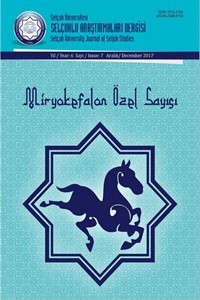Abstract
Ege ve Akdeniz Bölgelerinden İç Anadolu’ya geçiş kavşağında bulunan Pisidia Antiokheiası, Hellenistik, Roma İmparatorluk ve Bizans Dönemlerinde askeri kent olma özelliğini yitirmemiştir. Önemli bir yol kavşağında bulunan ve Hristiyanlığın haç merkezlerinden biri olan Antiokheia’nın isminin, Miryakefalon savaşını anlatan kroniklerden geçmemesi irdelenmiş ve Bizans ordusunun kullanmış olabileceği diğer yollar belirtilmiştir. Anadolu’nun Selçuklu egemenliğine geçmesini sağlayan Miryokefalon savaşının geçtiği düşünülen Kumdanlı ve Gelendost Yenice Boğazının konumları tartışılmış ve savaşın, Antiokheia yakınlarında olmadığı sonucuna varılmıştır.
Keywords
References
- Adnan Eskikurt, Myrionkefalon Savaşı’na Dair Kronikler ve Modern Çalışmalar, USAD, Bahar 2017; (6).
- John Julius Norwich, Bizans Gerileme ve Çöküş Dönemi (M. S. 1082 – 1453), 2013.
- Ksenophon, Anabasis, (trc. H. Örs), 1975 İstanbul.
- Mehmet Akif Ceylan – Adnan Eskikurt, Tarihi Coğrafya Açısından Myriokefalon Savaşı (17Eylül 1176) ve Konya Bağırsak Boğazı, Eylül 2017 Konya.
- Niketas Khoniates, Historia (Ioannes ve Manuel Komnenos Devirleri), (trc. F. Işıltan), TTK, Ankara 1995.
- Ramazan Topraklı, Değişen Coğrafya ve Miryokefalon Savaşı, Semih Ofset, Ankara 2011.
- William Mitchell Ramsay, Anadolu’nun Tarihi Coğrafyası, (trc. M. Pektaş), MEB. İstanbul 1960.
Abstract
Antioch of Pisidia, which was on the passing intersection of the Aegean and Mediterranean regions to the Central Anatolian region, was a military city during periods of the Hellenistic, the Roman Empire and the Byzantine Empire. The reason why the name of Antioch, which was one of the essential centres of Christianity and on an important intersection, was not stated in the chronicles narrating the Battle of Myriokephalon was scrutinised and the other routes which the Byzantine army could use were stated. The locations of Kumdanlı and Gelendost Yenice Gorge where the Battle of Myriokephalon, as a result of that Anatolia was domineered by Seljuks, was supposed to take place were discussed and it was concluded that the battle had not taken place near Antioch.
Keywords
References
- Adnan Eskikurt, Myrionkefalon Savaşı’na Dair Kronikler ve Modern Çalışmalar, USAD, Bahar 2017; (6).
- John Julius Norwich, Bizans Gerileme ve Çöküş Dönemi (M. S. 1082 – 1453), 2013.
- Ksenophon, Anabasis, (trc. H. Örs), 1975 İstanbul.
- Mehmet Akif Ceylan – Adnan Eskikurt, Tarihi Coğrafya Açısından Myriokefalon Savaşı (17Eylül 1176) ve Konya Bağırsak Boğazı, Eylül 2017 Konya.
- Niketas Khoniates, Historia (Ioannes ve Manuel Komnenos Devirleri), (trc. F. Işıltan), TTK, Ankara 1995.
- Ramazan Topraklı, Değişen Coğrafya ve Miryokefalon Savaşı, Semih Ofset, Ankara 2011.
- William Mitchell Ramsay, Anadolu’nun Tarihi Coğrafyası, (trc. M. Pektaş), MEB. İstanbul 1960.
Details
| Primary Language | Turkish |
|---|---|
| Journal Section | Articles |
| Authors | |
| Publication Date | September 27, 2018 |
| Published in Issue | Year 2017 Issue: 7 |
Cite
Selçuk University Journal of Seljuk Studies is licensed under a Creative Commons Attribution-NonCommercial 4.0 International License (CC BY NC).


